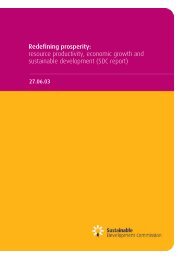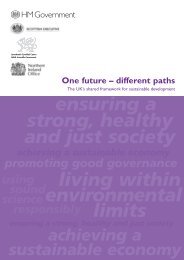Every Child's Future Matters - Sustainable Development Commission
Every Child's Future Matters - Sustainable Development Commission
Every Child's Future Matters - Sustainable Development Commission
Create successful ePaper yourself
Turn your PDF publications into a flip-book with our unique Google optimized e-Paper software.
• Walking or cycling to school are still popular<br />
choices for school journeys but are becoming<br />
less so. Figures show a drop from 58 per cent<br />
in 1989-91 to 47 per cent in 2003-4. 21<br />
For children aged five to ten school car runs<br />
rose from 38 per cent in 1995-97 to 43 per<br />
cent in 2005. 22 It is estimated that fewer<br />
than six out of ten girls and three out of<br />
ten boys obtain the Chief Medical Officer’s<br />
recommended daily level of physical activity<br />
for their age groups. 23 In adults, car use and<br />
its impact on reducing weekly walking has<br />
been estimated to lead to two stones of<br />
weight gain over a decade. 24<br />
• Evaluation of the Links to Schools programme<br />
finds that extending the National Cycle<br />
Network to schools has also improved young<br />
people’s accessibility to work, shops, friends<br />
and recreation places. 25<br />
• Even small amounts of green space (this<br />
term is used throughout as a shorthand for<br />
the parks, play areas and natural habitats<br />
accessible to a community – urban or rural)<br />
are shown to have qualities that facilitate<br />
relaxation and recovery from mental fatigue<br />
and stress. 26 Merely viewing nature through<br />
a window has health benefits. Time spent<br />
in green space has particular value for<br />
children with symptoms of attention deficit<br />
hyperactivity disorder, benefiting their<br />
concentration and self-discipline. 27<br />
• Researchers have calculated disabilityadjusted<br />
life years (DALYs) lost and deaths<br />
attributable to a range of environmental<br />
factors. They conclude that large proportions<br />
of deaths and DALYs in European children<br />
are attributable to outdoor and indoor air<br />
pollution, inadequate water and sanitation,<br />
lead exposure and injuries. Road traffic<br />
accidents account for 13.5 per cent of<br />
accidental deaths in 0-4 year olds, 28.1 per<br />
cent in 5-14 year olds and 26 per cent in<br />
15-19 year olds. 28<br />
• Research conducted by Sustrans in 40 schools<br />
showed that 45 per cent of pupils wanted to<br />
cycle, but just three per cent were doing so.<br />
Similarly, of the 35 per<br />
cent of children travelling<br />
to school by car, almost<br />
half of them would<br />
prefer not to. 29<br />
• Dummer, in a multi-site<br />
study using birth data<br />
from Cumbria, found<br />
excess perinatal and<br />
infant mortality due to<br />
spina bifida and heart<br />
defects in areas close<br />
to incinerators and<br />
crematoria, but the<br />
exact compounds<br />
responsible could not<br />
be determined. 30<br />
• Absorption rates of toxins<br />
in food are higher for children. For example,<br />
infants absorb as much as 50 per cent of the<br />
lead present in food unlike adults whose<br />
absorption is as little as 10 per cent. 31








